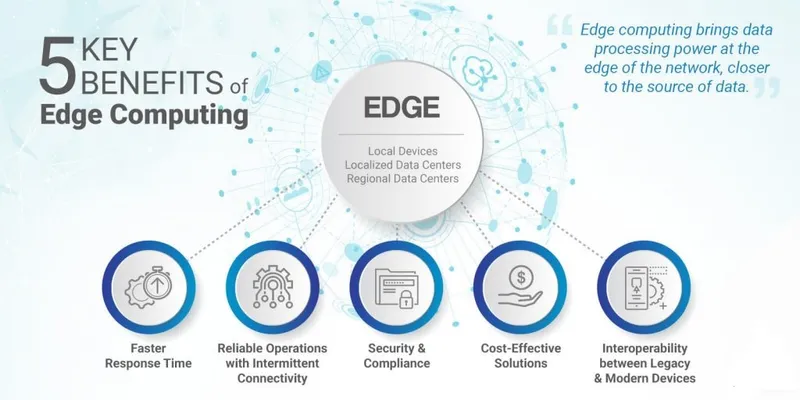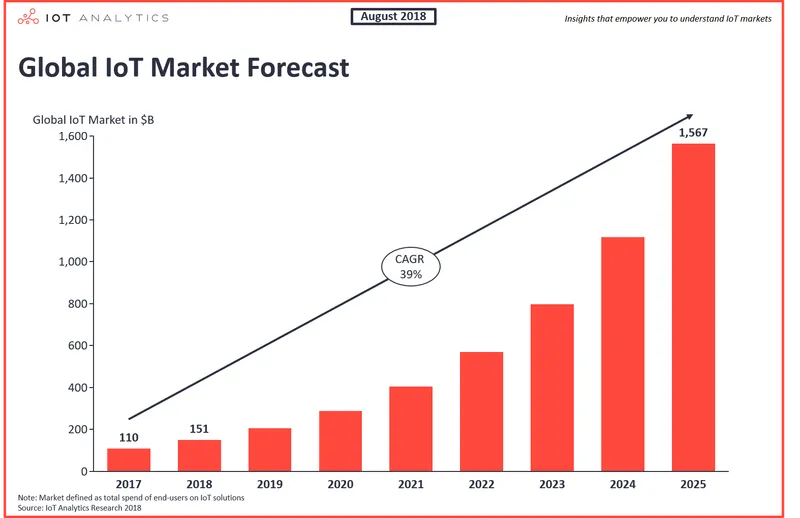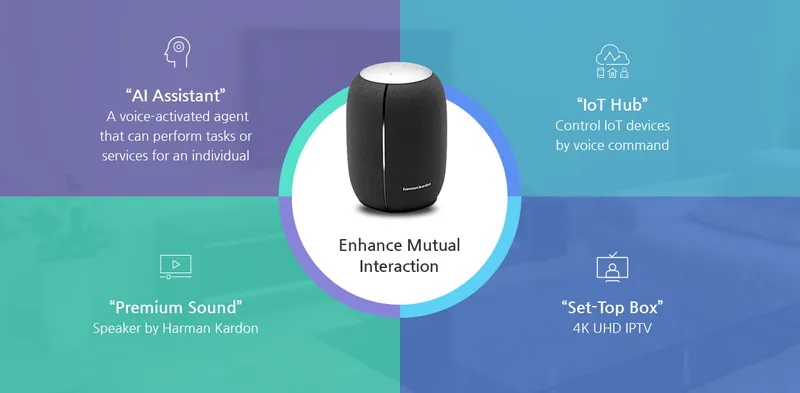

IoT To Be A Leading Edge For Businesses In 2019-20
IoT for Business

There is a lot of buzz about IoT in the business world when we look around. Since the world today is completely dependent on the internet, it has created a massive global network to allow communication between people. So every business is connected to each other and communicating through smart devices. Now comes IoT which collects data and deals with interconnections and devices.
IoT is playing an important role in our lives and serves as an ecosystem that interconnects objects and physical systems to perform tasks intelligently. Consumers demand devices that support IoT and many organizations are trying to capitalize it. So, it is shaping both the business & consumer worlds.
In this post, we would like to illuminate various IoT trends that bring innovation for businesses in 2019-20. Check out the list below:
1) Cloud IoT solutions
It is no more a surprise now that 2018 IoT Developer survey witnessed Azure cloud services and Microsoft's AWS as the best options for cloud development of IoT products. Both service providers in the cloud have the infrastructure, marketing, and accessibility required by the rapid release of new IoT devices.
Microsoft announced its new Azure IoT Central platform in 2018, enabling secure communication between devices and the cloud. This new service will cover the need for what is essentially a plug-and-play software solution to connect the IoT firmware to the cloud. Microsoft will continue to invest in its IoT infrastructure, pressing its clear support for the future of IoT and the potential it offers.
2) 5G Era Not So Far

5G era is going to bring potential opportunities for IoT devices. However, the era is very far from the mainstream adoption yet there are many organizations undertaking this. Thus, having a strong business plan in their hand with great reliability and reduced latency.
There are a number of things that are not possible in current 4G networks. Hence, reduced latency will allow connected IoT devices to send and receive data faster than ever, which will allow data analysis and management to work at a level. The list of applications for technology in embedded devices is long.
Any application that requires fast and uncompromised computing in the shortest possible time will generate enormous benefits of the technology. The transport sector will undoubtedly find a rapid integration for 5G enabled devices, as well as organizations that work in logistics or infrastructure.
3) Empowered by Artificial Intelligence
IoT has become ubiquitous today as it has crossed the number of the human population with its approx. 17B connected devices worldwide. These devices are used to collect data just like computers do but on a large scale.
Empowering IOT in Artificial intelligence brings ample of good opportunities for data analysis & interpretation. In fact, these devices soon will cover a major portion of the IoT market. Hence, AI and machine learning in IoT devices will bring huge benefits from device security to big data acquisition.
Face and voice recognition is the best example of this which can be used for biometric authentication in various domains. Big names like Amazon, Google, IBM, Microsoft are already using AI for their IoT devices. A self-driving car is another perfect example which can predict traffic patterns and safely brings its passengers to their respective destinations.
4) Edge Computing To Lead

Edge computing is ready to intervene if there is no cloud computing option for businesses. It is because always active connectivity is not a viable solution in all scenarios. Mobile IoT devices or those that work without enough network integration need a solution that can handle data processing, analysis, and execution.
The growing demand for intelligent IoT technology has driven the advancement of these programs, highlighting the need for edge computing chips that can take the computing power of the cloud and take it anywhere safely.
For instance, Amazon is already making a compelling case for edge computing solutions, along with its AWS IoT Greengrass service which gives developers the power to use Lambda functions with edge devices. This allows developers to perform machine learning and computation tasks within IoT devices.
5) Rise of Digital Twin Technology & Industrial IoT

IoT plays a major role in the manufacturing industry and thus making it less risky, more efficient and more worthy. There is a continuous growth in smart manufacturing which is actually growing exponentially these days due to the techno-industrial IOT revolution. Industrial IoT offers greater efficiency and productivity through the integration and analysis of data in a way that is not possible without an interconnected manufacturing process.
At the same time, digital twin technology is gaining great popularity. Through its use, organizations can create a clear picture of how their IoT devices interact with the manufacturing process. This allows software developers to understand how the life cycle of their machines works and allows them to predict the changes that may be necessary ahead of time. According to a Gartner survey, 48% of intelligent manufacturing adopters have made plans to use the concept of digital twins.
If you deploy this technology in your steel factory, it could prevent the overall downtime and health risks to the human at the same time. It allows engineers to track the number of factor operations and receive data in real time from sources via hands-free devices.
6) Voice-enabled IoT

Voice-enabled assistant is a driving force for smart business solutions, especially in the industrial sector. This technology uses hands-free control to quickly track processes and reduce maintenance and administration costs. This type of integration with the industrial IoT offers companies an easy-to-use communication method between the devices and their end users.
Solutions for biometric authentication also contribute to the growth of the market, since these voice assistant systems provide a convenient authentication method for secure platforms. As a natural platform for the integration of biometric security, voice assistant technology is already being used for these applications.
7) Blockchain, WebRTC: Complex IoT Solutions
Combining modern technologies with new business concepts actually work. It is because a successful business helps in reshaping the world of technology. So, it becomes necessary to combine new technologies with your business solutions. Here we will discuss the two complex IOT solutions:
-> WebRTC
It is abbreviated as web real-time communication which is an open source project that allows the development and implementation of bidirectional communication between IoT products through a simple browser, without the need for add-ons or special tools. It is experiencing widespread use, as it provides features and functions that would otherwise require significant development time, effort and ancillary tools.
Amazon's Alexa and Sensor use WebRTC for developing effective communication between the user and the device. These devices make smart home solutions which are functional and easy to use anytime anywhere.
-> Blockchain
As per the stats, blockchain is currently seeing used in various IOT devices. About 20% of devices have some form of blockchain service integrated into some data collection in 2019. By using blockchain, potentially unsafe device data can be maintained with a high degree of accuracy. Working as a digital accounting book for recorded information, blockchain distributes this data through the devices connected to the chain, making it impossible to modify the data accidentally or maliciously. Using this method, the data acquired from blockchain IoT devices can be considered reliable and safe.
Logistics and transportation solution one of the best examples for integration of IoT with blockchain. It can be used for real-time delivery tracking.
8) Facing Social, Legal, and Ethical Issues
The time is not far when IoT will find itself in a situation facing various legal and social questions. We are particularly talking about the data collected by IoT devices as this would fall under the category of GDPR(General Data Protection Regulation). As we know, this regulation maintains privacy and handles all personal data and now reaching beyond the European region. Hence, it is now important for all business to comply with the guidelines if they want to successfully operate within the EU.
To comply with the regulations, IOT developers need to put a serious concern on these questions while developing any new product. They must ensure compliance on each level of security including verification, data encryption or any other mechanism. This will give customer privacy and clearly made intentions for collected data and will give new buyers for the technology more confidence in purchasing IoT devices.
9) LPWAN for IoT sensors
LPWAN(Low power wide area network) with new advancements is offering more functionality to IoT devices. The wide effective range of LPWAN and extremely low power consumption makes it an ideal solution for small devices that need a longer lifetime in remote locations.
Any device that can work with the low LPWAN transmission rate, such as small sensors, does successful integration with LPWAN connectivity. The devices connected in this way are projected at more than one billion by 2023.
5 real-world best examples of IoT:
-> Amazon Go
-> Smart Home Solutions
-> Driverless Cars
-> Wearables
-> Smart Hotel Rooms
End Note
So far we have seen some major IOT trends for businesses in 2019-20. Hence, IoT development will connect businesses globally, enabling widespread visibility, proactive replenishment, and predictive maintenance.
With the IoT, data-driven decision making will become a standard in all industries and in our daily lives. If you know more of these trends then you are free to suggest us via the comments section. It will help us grow further.





